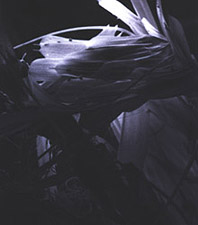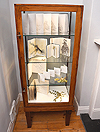
Katy Macleod
Writings:
What is writing?
15 Books




Poetry
Short stories

Vitrine: The Notebook Drawings
Molecular Laboratory: re-presenting timeA review of the work of Deborah RobinsonPhoenix and Bridge galleries, Exeter (UK) August, 2007 PROOF Autumn-Winter 2007 |
| This
exhibition is very much about how work is produced, how an artist
in a scientific laboratory conceives and makes art. It is a work-in-progress,
a laboratory of sorts which reflects on a very particular scientific
environment: the Wellcome Trust Sanger Institute in Cambridge.
This international laboratory is at the forefront of ground breaking
research into genetics, and played a major role in the human genome
project completed in 2004. It was here that Deborah Robinson extended
her artist in residence work which started three years earlier
with the Egenis research group at the University of Exeter. I
talked to Deborah about her work in her studio at Egenis, where
she talked freely about the whole process of working with scientists
whose job it is to produce research in the important area of genomics.
Genomics is the science which deals with genetic material, the
DNA, genes, and chromosomes within a particular organism. The
Egenis group's research is broadly within biological science,
however it concentrates on the social implications of work which
might, for instance, deal with GM crops, human ageing, or even
human cloning. In fact, much of their work is directed at a fuller
understanding of how to appropriately formulate what they find
to ensure that their work has an effective and socially useful
impact. In this context, it is a bewildering task for an artist
to make work which retains its integrity as art.
>Deborah
talked to me at length about her motivation to work in a research
science environment and how she wanted to make work in the actual
laboratories, the places where science knowledge is produced,
(because it might have been assumed that she would work with scientific
texts or data, for instance.) Here, scientists conduct endless
and very detailed experiments in an environment which is solely
geared to scientific inquiry, which must be conducted in an absolutely
clean and scrupulously managed space, because samples must be
uncontaminated and the data must be convincing if it is to further
the research field. How then does an artist make any kind of contribution
to this work? Like one of Deborah's key research sources, Joseph
Conrad's The Heart of Darkness,
she seeks what might have been overlooked, that question, as Conrad
puts it, which no-one has thought to ask. Of course, this is madly
ambitious but like so many wild endeavours from which we have
learnt, it was conceived through a simple method of practice;
she made small and unassuming pinhole cameras and placed them
in the laboratory. In my view, this has been a brilliant strategy,
because the pinhole camera, which is just a sealed cardboard box,
only records through the light responsive photographic paper inside.
It has no lens and only registers whatever the light creates on
this paper. Also, because it does this through an exceptionally
long exposure, 2.5 hours, in this case, it employs a kind of real
time, perhaps the length of time a scientist might work without
a tea break, for instance. However, although the pinhole work
at Washington Singer laboratories at the University of Exeter
records scientists' presence as they work, at the Sanger Institute,
increasingly laboratory
tasks are undertaken by robots. For an artist whose work comes
from an unalterably self conscious presence, the Sanger Institute
environment offered an extreme condition of research, vast laboratories
with minimal human engagement. In one's imagination these laboratories
might represent the fertile ground for monsters to be born because
that environment is completely alien to our everyday lives and
experience. The places where we all work involve social interaction
of some sort but if we think about Conrad's ideas again, it is
our ordinary day-to-day labour which dulls our sense of time;
by this he meant it dulls the complexity of what it is to fully
understand being alive and the stark knowledge that, as organisms,
we only die. Actually, it is this which The Heart of
Darkness, confronts, the kind
of insuperable muddle at the heart of living, which is a huge
endeavour if we travel far out emotionally, psychologically and
intellectually and also just a physical, day-to-day business of
survival. We like to stave off too much thought to get on with
the physical business of living and try to avoid travelling too
far into deep questions about what life means, unlike the hero
in The Heart of Darkness,
Marlow; he journeys way out of nineteenth century Europe to encounter
what he'd seen on maps in his childhood as 'blank spaces' in the
world, such as Africa, an environment right outside his knowledge.
The Sanger laboratories lie outside our familiar environments,
also perhaps our concept of research. In this context, the one
laboratory image that Deborah chose to discuss at length also
registers a 'blankness' or emptiness, a large white space at its
centre, at odds with the very efficient looking equipment all
round the laboratory, where even light is a contaminant. This
image seems to suggest that the laboratory might be a place where
the unanticipated could take shape, where knowledge might somehow
be withheld, an uncharted space, where as Deborah puts it, knowledge
is in abeyance.
In
this exhibition then what you will see is pinhole photographic
evidence of science laboratory environments. In these places,
Deborah Robinson has produced work which is about what such environments
might hold beyond the production of science, perhaps a closer
understanding of what it might feel like to be in an unknown space,
perhaps a space where knowledge cannot be grasped because certain
experience is so very difficult to put into words. This is particularly
the case with making a painting, which is Deborah's main art practice,
because on one level paint is just stuff 'a sludge' on a surface,
while on another, it can be 'deeply alive, full of thought and
expressive meaning' as James Elkins puts it in What Painting
Is. In this exhibition of art research conducted in the
Sanger Institute, you will see photographic images which may just
register the stuff of a laboratory, what it is and what it includes,
but you might also see other less predictable things such as the
strange forms made by light as it takes up and casts aside the
clear shapes of scientific equipment. For the scientists working
alongside Deborah at Washington Singer laboratories, her work
has made the familiar unfamiliar and that, it must be said, is
the most socially effective role an artist has.
|
CV Publications  Curation & Catalogue   Links |